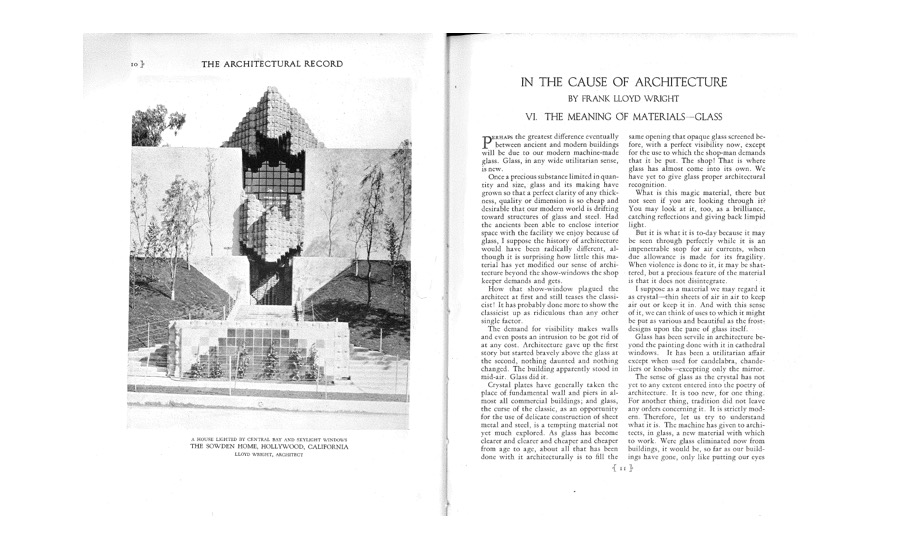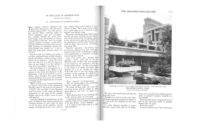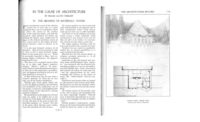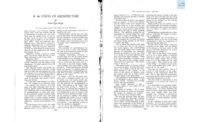The Mirror is seen in Nature in the surfaces of lakes in the hollows of the mountains and in the pools deep in shadow of the trees; in winding ribbons of the rivers that catch and give back the flying birds, clouds and blue sky. A dreary thing to have that element leave the landscape. It may be as refreshing and as beautifying in architecture, if architecturally used. To use it so is not easy, for the tendency toward the tawdry is ever present in any use of the mirror.
But to extend the vista, complete the form, multiply a unit where repetition would be a pleasure, lend illusion and brilliance in connection with light-effects – all these are good uses to which the architect may put the mirror. As a matter of fact he never uses plate-glass in his windows or indoors inside his buildings that he does not employ the same element in his architecture that the limpid pool presents in the landscape – susceptible to reflections. And this opportunity is new. It is a subtle beauty of both exterior and interior, as may be readily seen in the effect of the exterior if a poor quality of cylinder glass be substituted for polished plate-glass. Perhaps no one other change in the materials in which any building is made could so materially demoralize the effect of the whole as this substitution.
In the openings in my buildings, the glass plays the effect the jewel plays in the category of materials. The element of pattern is made more cheaply and beautifully effective when introduced into the glass of the windows than in the use of any other medium that architecture has to offer. The metal, even gold or silver – the glass a subordinate, rhythmical accent of any emotional significance whatever, or vice versa. The pattern may be calculated with reference to the scale of the interior and the scheme of decoration given by, or kept by, the motif of the glass pattern.
I have used opalescent, opaque, white and gold in the geometrical groups of spots fixed in the clear glass. I have used, preferably, clear primary colors, like the German flashed-glass, to get decorative effects believing the clear emphasis of the primitive color interferes less with the function of the window and adds a higher architectural note to the effect of the light itself. The kinder-symphony in the windows in the Coonley play-house is a case in point. The sumac windows in the Dana dining-room another. This resource may be seen in most of my work, varied to suit conditions. This is a resource commonly employed in our buildings but usually overdone or insufficiently conventionalized. Nothing is more annoying to me than any tendency toward realism of form in window-glass, to get mixed up with the view outside. A window pattern should stay severely “put.” The magnificent window-painting and plating of the windows of the religious edifice is quite another matter. There the window becomes primarily a gorgeous painting – painting with light itself – enough light being diffused to flood the interior dimly. This is an art in itself that reached its height in the Middle Ages. Probably no greater wealth of pictorial color-effect considered as pure decoration exists in the world than in the great rose-windows and pointed-arches of the cathedral.
But, the glass and bronze building is the most engaging of possibilities in the modern architecture. Imagine a city iridescent by day, luminous by night, imperishable! Buildings – shimmering fabrics – woven of rich glass – glass all clear or part opaque and part clear – patterned in color or stamped to form the metal tracery that is to hold all together to be, in itself, a thing of delicate beauty consistent with slender steel constructing – expressing the nature of that construction in the mathematics of structure which are the mathematics of music as well. Such a city would clean itself in the rain, would know no fire alarms – nor any glooms. To any extent the light could be reduced within the rooms by screens, a blind, or insertion of opaque glass. The heating problem would be no greater than with the rattling windows of the imitation masonry structure, because the fabric now would be mechanically perfect – the product of the machine shop instead of the makeshift of the field.
I dream of such a city, have worked enough on such a building to see definitely its desirability and its practicability.
Beauty always comes to and by means of a perfect practicability in architecture. That does not mean that the practicability may not find idealization in realization. On the contrary. Because that is precisely what architecture does and is when it is really architecture. Architecture finds idealization in realization or the reverse if you like.
Then, too, there is the lighting fixture – made a part of the building. No longer an appliance nor even an appurtenance, but really architecture.
This is a new field. I touched it early in my work and can see limitless possibilities of beauty in this one feature of the use of glass. Fortunately this field has been more developed than any other. The sense of integral lighting seems to come more easily and naturally because there was no precedent to impede progress. And as it is now with the lighting feature, so will it soon be a disgrace to an architect to have left anything of a physical nature whatsoever, in his building unassimilated in his design as a whole.
Integral lighting began with this ideal in mind in my work thirty-one years ago, as may be seen in the play-room ceiling and in the dining room ceiling of my former house in Oak Park. Also in the ceiling of my studio library in that building. Perhaps it might be said to have begun earlier than that in the Auditorium by Adler and Sullivan where the electric lights became features of the plaster ornamentation. The lights were not incorporated, but they were provided for in decoration as accents of that decoration.
Glass and light – two forms of the same thing!
Modern architecture is beckoned to a better reckoning by this most precious of the architect’s new material. As yet, little has been done with it but the possibilities are large.
This great gift of glass is of the machine, - for today mechanical – processes are as much the Machine as any other of its factors.








Post a comment to this article
Report Abusive Comment